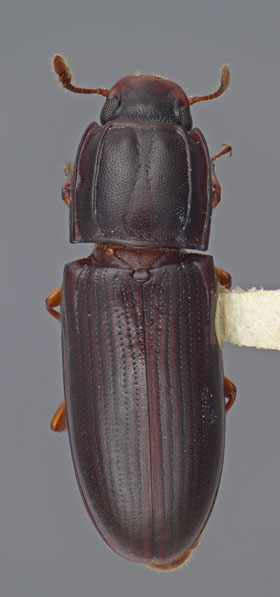 |
 Previous Genus Next Genus Previous Genus Next Genus 
Genus: Aulonium
Diagnostic Features
- Description: Body elongate, subcylindrical to subdepressed. Antennae 11-segmented with a 3-segmented club. Antennal setation sparse. Subantennal grooves absent. Eyes ovate, well-developed, coarsely faceted. Eyes emarginate anteriorly by projection of frons, forming a distinct canthus. Pronotum subquadrate to elongate, sides nearing parallel. Pronotal disc often with pair of sublateral carinae and pair of faint submedial lines, anterior portion of disc usually with pair of sulci or knob-like tubercles. Procoxal cavities narrowly closed. Metacoxae narrowly separated, separation less than metacoxal length. Tarsal formula 4-4-4. Apex of protibia expanded, armed with a stout, apical spine. Dorsal surface glabrous, moderately shiny.
- Similar genera: The genus Aulonium is superficially similar in general appearance to Colydium. The carinate elytral declivity and presence of a pair of long setae near the apical margin of the last abdominal ventrite serve to distinguish Colydium. The genus Phloeonemus also has emarginated eyes formed by a projection of the frons, but is readily distinguished from Aulonium and Colydium by the 2-segmented antennal club, lack of a stout apical spine on the protibia, explanate lateral pronotal margins, very different sculpturing of the pronotal disc.
Known Distribution
- Northwest (ID, MT, OR, WA), Southwest (AZ, CA, CO, NM, NV, UT), North Central (SD, IL, IN, MI, OH), Northeast (DC, DE, NJ, NY, MA, MD, PA, WV, VA), Southeast (AL, FL, GA, KY, NC, SC, TN), South Central (AR, LA, MS, OK, TX) USA, and British Columbia, Canada.
Biology
- Aulonium has been collected at MV/UV lights and from under the bark of various dead hardwoods and conifers. Adults and larvae of Aulonium have been found in the galleries of scolytine weevils (Curculionidae), and they are suspected to feed on the larvae of those beetles within the galleries (Ivie, 2002; Craighead, 1920; Marshall, 1978; Podoler et al., 1990). This genus is a beneficial insect, attacking destructive wood boring beetles.
- Abundance: Moderately common.
North American Species (5)
Species Diagnoses
- Aulonium aequicolle: Western species. Pronotum quadrate, as long as wide. Anterior pronotal margin nearly straight. Sublateral carinae slightly curved basally, not distinctly raised anteriorly, merge with raised anterior margin of pronotum. Submedial lines diverge apically and basally, narrowed in apical 1/3. Pronotal disc more or less convex, slightly depressed in between submedial lines. Tubercles of anterior margin of pronotum not sexually dimorphic – in both sexes tubercles extremely reduced or absent. Strial rows of elytra distinct, punctures larger. Color usually piceus. Rarely collected. Associated with oaks. Distribution: Arizona, California, USA.
- Aulonium ferrugineum: Eastern species. Body more elongate, 3.6x longer than wide. Pronotum nearly quadrate, distinctly longer than wide. Anterior pronotal margin concave. Sublateral carinae straight basally, distinctly raised and strongly carinate anteriorly. Tubercles of anterior margin of pronotum not sexually dimorphic – in both sexes tubercles extremely reduced or absent. Submedial lines parallel in anterior half, diverging in basal half. Pronotal disc more or less convex, slightly depressed in between submedial lines. Strial rows of elytra indistinct, punctures minute. Color ferrugineous throughout. Associated with pines. Distribution: Pennsylvania, Florida, Georgia, Oklahoma, Texas, Alabama, North Carolina, South Carolina, USA.
- Aulonium longum: Western species. Pronotum quadrate, slightly longer than wide. Anterior pronotal margin sinuate. Sublateral carinae straight basally, distinctly raised and strongly carinate anteriorly. Submedial lines parallel, weak, only present in basal half. Pronotal disc strongly excataved in central 1/3. Tubercles of anterior margin of pronotum sexually dimorphic – in males, tubercles strongly raised, in females, tubercles reduced, only slightly raised. Strial rows of elytra indistinct, punctures minute. Color usually reddish brown. Commonly collected. Associated with pines. Distribution: Arizona, California, New Mexico, Idaho, Nevada, Oregon, Utah, Washington, Colorado, Montana, South Dakota, USA; British Columbia, Canada.
- Aulonium parallelopipedum: Eastern species. Body slightly broader and shorter, 3x longer than wide. Pronotum quadrate. Sublateral carinae slightly curved basally, not distinctly raised anteriorly, merge with raised anterior margin of pronotum. Anterior pronotal margin slightly sinuate. Submedial lines diverge apically and basally, narrowed in apical 1/3. Pronotal disc more or less convex, slightly depressed in between submedial lines. Tubercles of anterior margin of pronotum not sexually dimorphic – in both sexes, tubercles present but not distinctly produced, slightly larger in males. Strial rows of elytra distinct, punctures larger. Color piceus. Associated strictly with hardwoods. Distribution: Washington D.C., Delaware, Illinois Indiana, Massachusetts, Maryland, Michigan, New Jersey, New York, Ohio, Pennsylvania, Alabama, Arkansas, Florida, Georgia, Kentucky, Louisiana, Mississippi, North Carolina, South Carolina, Tennessee, Virginia, Oklahoma, Texas, USA.
- Aulonium tuberculatum: Eastern species. Body more elongate, 3.6x longer than wide. Pronotum nearly quadrate, distinctly longer than wide. Anterior pronotal margin sinuate. Sublateral carinae straight basally, distinctly raised and strongly carinate anteriorly in males, not strongly raised anteriorly in females. Tubercles of anterior margin of pronotum distinctly sexually dimorphic – in males, tubercles strongly raised, with an additional pair of raised areas beneath, in females, tubercles absent. Submedial lines parallel, extremely weak. Pronotal disc weakly excataved in central 1/5 in males only. Strial rows of elytra indistinct, punctures minute. Color ferrugineous, with elytral apex darker. Associated with pines. Distribution: Washington, D.C., Indiana, Maryland, New Jersey, New York, Pennsylvania, Alabama, Florida, Georgia, Louisiana, Mississippi, North Carolina, South Carolina, Virginia, West Virginia, Oklahoma, Texas, USA.
Potential Problems with Identification
- The species of Aulonium seem to fall into two distinct groups, the A. aequolle, A. parallelopipedum group defined by the larger, darker body and lack of tubercles near the anterior margin of the pronotum, and the A. longum, A. tuberculatum, A. ferrugineum group, with the more elongate body and presence of tubercles (except in A. ferrugineum) near the anterior margin of the pronotum. These species can be distinguished by the characters given above, but separation of species within the genus becomes much more difficult on a worldwide scale.
Selected References
|
 |
 
Aulonium aequicolle
© N.P. Lord |


